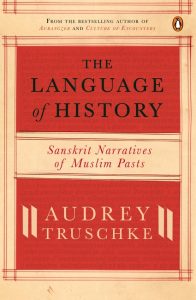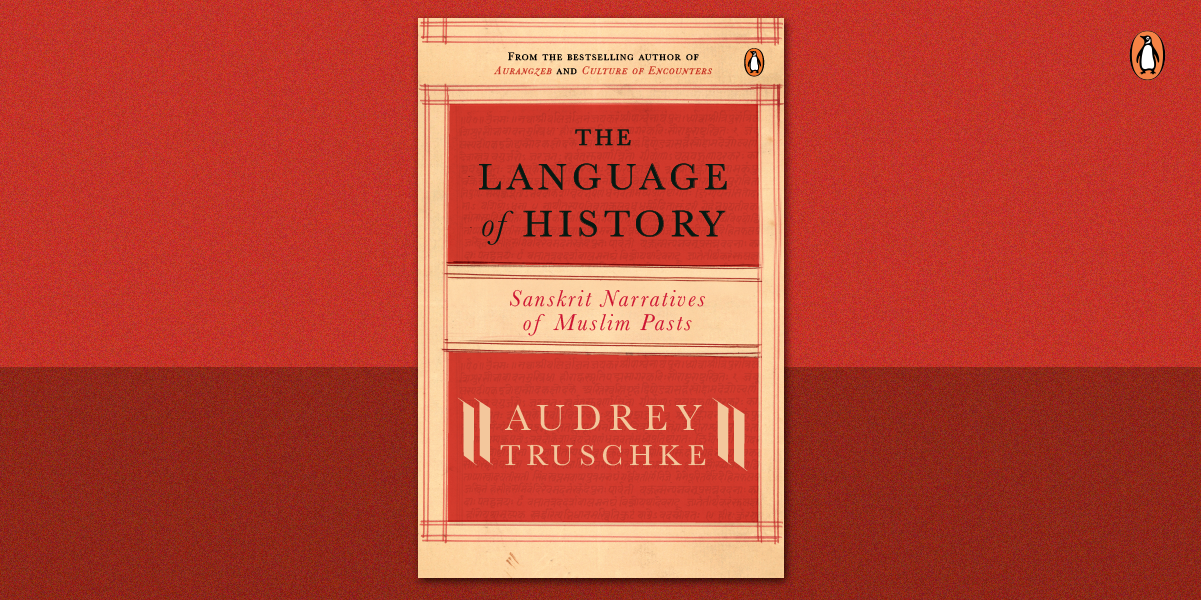The Language of History by Audrey Trushchke analyses a hitherto overlooked group of histories on Indo-Muslim or Indo-Persian political events, namely a few dozen Sanskrit texts that date from the 1190s until 1721. This book seeks, for the first time, to collect, examine and theorize Sanskrit histories on Muslim-led and, later, as Muslims became an integral part of Indian cultural and political worlds, Indo-Muslim rule as a body of historical materials. This archive lends insight and perspectives into formulations and expressions of premodern political, social, cultural and religious identities.
Here is an excerpt from the chapter titled Local Stories in Fourteenth-Century Gujarat and Fifteenth-Century Kashmir.
*
Different perspectives, different storytellers, always complicate the narrative; that’s good because what we are trying to make sense of is complex.
—Githa Hariharan, 2016 interview
As Indo-Muslim rulers made further inroads into parts of the Indian subcontinent from the fourteenth century onwards, authors developed locally based traditions of Sanskrit historical writing that detailed this political trend. In this chapter, I investigate and compare two regional traditions that took off in the fourteenth century and fifteenth century, respectively: Gujarati prabandhas and Kashmiri rajataranginis. Gujarat and Kashmir had both witnessed Muslim-led military activities and, at least in parts, Muslim- led rule for centuries prior to the inauguration of these respective bodies of Sanskrit texts. Both sets of materials narrate some of that history as relevant to their region. Additionally, because they are plural rather than single texts, these materials allow me to compare authorial choices and see trends and exceptions within a deepening interest in Indo-Muslim history among premodern Sanskrit intellectuals.

The Gujarati and Kashmiri materials that I discuss here differ from each other in numerous ways. Four Gujarati texts were composed within a tight time-frame, dating between 1301 and 1349. A trio of Kashmiri works stretch across more than three centuries, with Kalhana penning his Rājataraṅgiṇī (River of Kings) in 1149 and two successors writing in 1459 and 1486, respectively. The two series of texts were authored by men belonging to different religious communities: Shvetambara Jains (prabandhas) and Kashmiri Brahmins (rajataranginis). They exhibit distinct styles and foci. Nonetheless, both constitute regionally based Sanskrit traditions of history writing in areas shaped, relatively early on, by Muslim-led political activities. I consider Gujarati prabandhas and Kashmiri rajataranginis together here, not as two sides of the same coin but rather as two distinct local traditions. When read against each other, these series of texts enable us to sketch out the increasingly complex contours of Sanskrit historical writing on Muslim-led incursions and rule in the fourteenth and fifteenth centuries.
Pairing Difference in Gujarati and Kashmiri Materials
The Gujarati and Kashmiri works both addressed local audiences, although delineated in rather different ways. Jain monks envisioned the four prabandhas I discuss below as being inspirational to the Jain faithful. Two authors, Merutunga and Rajashekhara, penned collections of stories about Jain ascetics and laymen. The other authors—Kakka, Jinaprabha and Vidyatilaka (Jinaprabha’s continuer)—structured their narratives around Jain pilgrimage destinations. Extant manuscript evidence indicates that the four prabandhas were often read in and around Gujarat. In contrast, Kashmiri Brahmins penned the first three rajataranginis for a more politically defined audience. Kalhana, who completed the inaugural Rājataraṅgiṇī in 1149, claimed to write for others who lived through the vicissitudes of sovereignty. For Kalhana, this was a personal subject since his father had been ousted from the court of King Harsha (r. 1089–1101), leaving Kalhana unemployed. Kalhana’s chronicle found a reception, a bit ironically, among those who enjoyed royal patronage, and Jonaraja and Shrivara, the authors of the next two rajataranginis—who imitated Kalhana in style and focus—were court poets of the Shah Miri dynasty. The Rājataraṅgiṇīs of Jonaraja and Shrivara doubled as extensions of Kalhana’s text and as official court chronicles for an Indo-Persian polity.
Despite the distinct origins of these two bodies of historical materials, the founding authors of both local traditions envisioned the same key antecedent: the Sanskrit epic Mahabharata. Kalhana alludes to the Mahabharata throughout his work and also assigns his chronicle the same unusual aesthetic goal attributed to the epic in the Kashmiri thought of his time, namely, inducing quiescence (śāntarasa) in the reader who would shun the world after perusing the monstrous cycle of politics. Merutunga, who penned the earliest prabandha work I discuss here, was more direct. In an opening verse, he billed his Prabandhacintāmaṇi (Wishing-Stone of Narratives, 1305) as ‘pleasing like the Mahabharata’. Neither Kalhana nor Merutunga refer to any of the historical materials that I have dealt with earlier in this book, which accords with the generally fractious nature of Sanskrit historical writing on Indo-Muslim political events. But neither did these authors posit their works as clean breaks with the Sanskrit literary tradition. Rather, the authors imagined themselves as updating established ways of writing about past events in Sanskrit, modernizing (or early modernizing?) them for new times and in response to new occurrences. Analysing the prabandhas and rajataranginis together here underscores the self-proclaimed continuity of both sets of authors as well as their differences in interpreting what it meant to write political history in Sanskrit.
Kalhana and Merutunga headline focusing on the present as a crux of their innovation. Again, Merutunga is more forthcoming. In an opening verse, he claims that his work narrates recent history (vṛttaistadāsannasatāṃ), which sets it apart from old stories (kathāḥ purāṇāḥ). Kalhana indicates his emphasis on recent history by becoming more precise and verbose as he comes closer to his present day, such that his later chapters, on events increasingly close to his own time, are far longer and denser than his earlier ones.9 More than half of Kalhana’s Rājataraṅgiṇī concerns the sixty years prior to the text’s composition. In this emphasis on recent history, Kalhana’s Rājataraṅgiṇī is a far cry from the Mahabharata epic that was always, even in its own internal frameworks, about times and people that were long gone. More generally, the prabandhas and rajataranginis I discuss here concentrate on the lives of real, historical people and sometimes include specific dates and citations of sources. Their authors coupled these historiographical innovations with an incorporation of stories about how Indo-Muslim political actors were shaping the contemporary political and social realities of Gujarat and Kashmir, respectively. By reading these two bodies of works side by side, we can see both their shared similarities and substantial divergences that added texture and depth to the growing tradition of Sanskrit historical writing.
**







